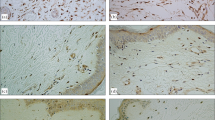Abstract
The goal of the present study is to examine the level of transforming growth factor-β (TGF-β) in fibroblasts and blood microvessels of the human dermis from the development until deep aging (from 20 weeks’ gestation to 85 years of age), and to determine the role of TGF-β in age-dependent changes in the number of fibroblasts and blood microvessels in the dermis. The contents of TGF-β, proliferating cell nuclear antigen (PCNA), and endothelial cell marker CD31 are assessed with the indirect immunohistochemical technique. The results show an increase in the of the proportion of the fibroblasts stained positive for TGF-β in the dermis from 20 weeks’ gestation until 85 years of age. A greater increase in the percentage of TGF-β positive fibroblasts in the human dermis is observed after birth and after the age of 40 years. The content of TGF-β in the blood microvessels of the human dermis decreases significantly after the age of 41 years. An age-related increase in the proportion of fibroblasts stained positive for TGF-β is associated with an age-related reduction of the total number and the percentage of PCNA positive fibroblasts in the human dermis. An age-related decrease in the content of TGF-β in blood microvessels is accompanied by an age-related decrease in their number in the dermis. An age-related increase in the fibroblast content of TGF-β is associated with an age-dependent decrease in their total number and proliferation in the dermis. The age-related reduction of TGF-β content in blood microvessels of dermis is associated with an age-related decrease in the number of blood microvessels in the dermis.




Similar content being viewed by others
REFERENCES
Gunin, A.G. and Golubtsova, N.N., Thyroid hormone receptors in human skin during aging, Adv. Gerontol., 2018, vol. 8, no. 3, pp. 216–223.
Gunin, A.G., Petrov, V.V., Vasilieva, O.V., and Golubtsova, N.N., Age-related changes of blood vessels in the human dermis, Adv. Gerontol., 2015, vol. 5, no. 2, pp. 65–71.
Fritz, P., Hones, J., Lutz, D., et al., Quantitative immunohistochemistry: standardization and possible application in research and surgical pathology, Acta Histochem., 1989, vol. 37, suppl., pp. 213–219.
Gunin, A.G., Kornilova, N.K., Vasilieva, O.V., and Petrov, V.V., Age-related changes in proliferation, the numbers of mast cells, eosinophils, CD45 positive cells in human dermis, J. Gerontol., Ser. A, 2011, vol. 66, pp. 385–392.
Gunin, A.G., Petrov, V.V., Golubtzova, N.N., et al., Age-related changes in angiogenesis in human dermis, Exp. Gerontol., 2014, vol. 55, pp. 143–151.
Haque, S. and Morris, J.C., Transforming growth factor-β: a therapeutic target for cancer, Hum. Vaccines Immunother., 2017, vol. 13, pp. 1741–1750.
Kawamura, H., Nakatsuka, R., Matsuoka, Y., et al., TGF-β signaling accelerates senescence of human bone-derived CD271 and SSEA-4 double-positive mesenchymal stromal cells, Stem Cell Rep., 2018, vol. 10, pp. 920–932.
Qin, Z., Xia, W., Fisher, G.J., Voorhees, J.J., and Quan, T., YAP/TAZ regulates TGF-β/Smad3 signaling by induction of Smad7 via AP-1 in human skin dermal fibroblasts, Cell. Commun. Signaling, 2018, vol. 16, p. 18.
Rizzardi, A.E., Johnson, A.T., Vogel, R.I., et al., Quantitative comparison of immunohistochemical staining measured by digital image analysis versus pathologist visual scoring, Diagn. Pathol., 2012, vol. 7, p. 42.
Seidal, T., Balaton, A.J., and Battifora, H., Interpretation and quantification of immunostains, Am. J. Surg. Pathol., 2001, vol. 25, pp. 1204–1207.
Wang, A.S. and Dreesen, O., Biomarkers of cellular senescence and skin aging, Front. Genet., 2018, vol. 9, p. 247.
Wang, Z., Perez, M., Lee, E.S., Kojima, S., et al., The functional relationship between transglutaminase 2 and transforming growth factor-β1 in the regulation of angiogenesis and endothelialmesenchymal transition, Cell Death Dis., 2017, vol. 8, p. e3032.
Wei, W. and Ji, S., Cellular senescence: molecular mechanisms and pathogenicity, J. Cell Physiol., 2018. https://doi.org/10.1002/jcp.26956
Zonneville, J., Safina, A., Truskinovsky, A.M., et al., TGF-β signaling promotes tumor vasculature by enhancing the pericyteendothelium association, BMC Cancer, 2018, vol. 18, p. 670.
Funding
This work was supported by RFBR and Chuvash Republic (16-44-210018, 18-44-210001).
Author information
Authors and Affiliations
Corresponding author
Ethics declarations
The authors declare that they have no conflict of interest. The study was approved by the Ethics Committee of the Medical faculty of Ulianov Chuvash State University.
Additional information
Translated by I. Matiulko
Rights and permissions
About this article
Cite this article
Gunin, A.G., Golubtzova, N.N. Transforming Growth Factor-β (TGF-β) in Human Skin during Aging. Adv Gerontol 9, 267–273 (2019). https://doi.org/10.1134/S2079057019030068
Received:
Revised:
Accepted:
Published:
Issue Date:
DOI: https://doi.org/10.1134/S2079057019030068



